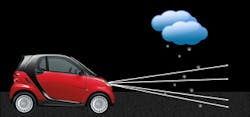Smart headlights from Carnegie Mellon University let drivers see through rain
Pittsburgh, PA--Researchers at Carnegie Mellon University's Robotics Institute have invented a smart headlight system that they say can improve visibility when driving at night in a rainstorm or snowstorm by constantly redirecting light to shine between particles of precipitation. Demonstrated in laboratory tests, the system prevents the distracting and sometimes dangerous glare that occurs when headlight beams are reflected by precipitation back toward the driver. "If you're driving in a thunderstorm, the smart headlights will make it seem like it's a drizzle," said Srinivasa Narasimhan, associate professor of robotics.
The system uses a camera to track the motion of raindrops and snowflakes and then applies a computer algorithm to predict where those particles will be just a few milliseconds later. The light projection system then adjusts to deactivate light beams that would otherwise illuminate the particles in their predicted positions. To people, rain can appear as elongated streaks that seem to fill the air. To high-speed cameras, however, rain consists of sparsely spaced, discrete drops. That leaves plenty of space between the drops where light can be effectively distributed if the system can respond rapidly, Narasimhan said.
In their lab tests, Narasimhan and his research team demonstrated that their system could detect raindrops, predict their movement and adjust a light projector accordingly in 13 ms. At low driving speeds, such a system could eliminate 70 to 80% of visible rain during a heavy storm, while losing only 5 or 6% of the light from the headlamp. To operate at highway speeds and work effectively in snow and hail, the system's response will need to be reduced to just a few milliseconds, Narasimhan said. The lab tests have demonstrated the feasibility of the system, however, and the researchers are confident that the speed of the system can be boosted.
The test apparatus, says Carnegie Mellon, couples a camera with an off-the-shelf digital light processing (DLP) projector. Road-worthy systems likely would be based on arrays of light-emitting diode (LED) light sources in which individual elements could be turned on or off, depending on the location of raindrops. New LED technology could make it possible to combine LED light sources with image sensors on a single chip, enabling high-speed operation at low cost. Narasimhan's team is now engineering a more compact version of the smart headlight that in coming years could be installed in a car for road testing.
Though a smart headlight system will never be able to eliminate all precipitation from the driver's field of view, simply reducing the amount of reflection and distortion caused by precipitation can substantially improve visibility and reduce driver distraction. Another benefit is that the system also can detect oncoming cars and direct the headlight beams away from the eyes of those drivers, eliminating the need to shift from high to low beams.
This research was sponsored by the Office of Naval Research, the National Science Foundation, the Samsung Advanced Institute of Technology and Intel Corp. Collaborators include Takeo Kanade, professor of computer science and robotics; Anthony Rowe, assistant research professor of electrical and computer engineering; Robert Tamburo, Robotics Institute project scientist; Peter Barnum, a former robotics Ph.D. student now with Texas Instruments; and Raoul de Charette, a visiting Ph.D. student from Mines ParisTech, France.
SOURCE: Carnegie Mellon University; www.cmu.edu/news/stories/archives/2012/july/july9_smartheadlights.html
About the Author

Gail Overton
Senior Editor (2004-2020)
Gail has more than 30 years of engineering, marketing, product management, and editorial experience in the photonics and optical communications industry. Before joining the staff at Laser Focus World in 2004, she held many product management and product marketing roles in the fiber-optics industry, most notably at Hughes (El Segundo, CA), GTE Labs (Waltham, MA), Corning (Corning, NY), Photon Kinetics (Beaverton, OR), and Newport Corporation (Irvine, CA). During her marketing career, Gail published articles in WDM Solutions and Sensors magazine and traveled internationally to conduct product and sales training. Gail received her BS degree in physics, with an emphasis in optics, from San Diego State University in San Diego, CA in May 1986.
